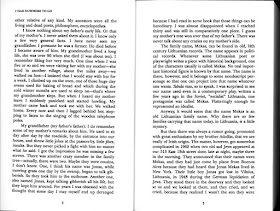I Had Nowhere to Go
Newfane, USA: Black Thistle Press, 1991
470 pp., 1.5 x 5.5 x 8.2", softcover
Edition size unknown
"I’m ashamed of how much space in my diaries I am giving to what we eat," writes Jonas Mekas in I Had Nowhere to Go, which covers the filmmaker's diaries from 1944 to 1955, " I know many a reader will put me down, because of that. But that is the reality of our lives, these days. You try to stick to the spirit, but the stomach wins."
This passage speaks both to the daily struggle for survival, with the rations supplied by International Relief Organizations being woefully insufficient, and also that the artist imagined himself writing for an eventual audience. It would be 47 years before the diaries were published.
The first entry is dated July 19th, 1944 - a year and six weeks before the end of the war. Mekas is twenty-two and aboard a train with many other refugees, fleeing Lithuania. His train is soon stopped in Germany and he and his brother Adolfas are imprisoned in a Nazi labor camp in Elmshorn for eight months. They eventually escaped but were detained near the Danish border where they hid on a farm until the end of the war. Mekas then lived in displaced person camps in Wiesbaden and Kassel.
He studied philosophy at the University of Mainz from 1946 to 1948, and before emigrating with his brother to the U.S. in 1949. They settled in Williamsburg, Brooklyn. He bought his first Bolex 16mm camera with borrowed money just two weeks after he arrived in New York, inspired by the avant-garde films he had seen at Amos Vogel's Cinema 16 film society.
In 1954, he and Adolfas founded Film Culture magazine. Later he would write an influential column for the Village Voice and start Anthology Films, one of the world’s largest and most important repositories of avant-garde film. He would collaborate with artists such as Andy Warhol, Nico, Allen Ginsberg, Yoko Ono, John Lennon, Salvador Dalí, and Fluxus impresario George Maciunas (a fellow Lithuanian).
The filmmaker's diaries begin with a year's worth of entries before he even mentions cinema: in October of 1945 he goes to see Charlie Chaplin’s The Goldrush. In 1947 he writes: “Everybody’s signing up for Canada. Mostly they are looking for tailors, shoemakers, professions like that. It’s enough to know how to sew a button on-you are hired. No requests for poets yet.”
In an entry from December 30th, 1951, Mekas tells a fable about a man who wishes to know what's at the end of the world and sets out on a multi-year long journey, only to discover nothing more than a pile of rabbit excrement. Twenty years later the same story would be recounted in the unfinished film The Rabbit Shit Haikus, extending the tale to follow the man's return home, where no one believes him.
Author, poet and film critic Phillip Lopate praised the diaries, noting the "aching honesty, puckish humor and quiet nobility of character." "I was enormously moved by it," wrote Allen Ginsberg.
Twenty-five years after it's publication, and sixty-one years after it's completion, Douglas Gordon has adapted the book into a film, which makes its North American debut at the Toronto International Film Festival tomorrow.
The feature-length film (97 minutes) reportedly contains only ten minutes of visuals. The rest of I Had Nowhere to Go: Portrait of a Displaced Person features a black screen, with the accompanying audio tasked with telling the story. It is narrated by Mekas, now 93.
The film premieres this Sunday, September 11, 2016, at 4:30pm. The book is still available from the publisher, here.























No comments:
Post a Comment